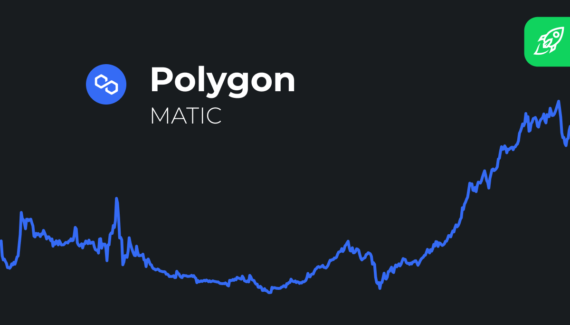ATTENTION! The Ethereum blockchain finished its transition to proof of stake on September 15, 2022. This means that ETH can no longer be mined. Instead, it can now be staked: read more about it here. If you are interested in mining, you can check out our articles about it by looking up the appropriate tag — changelly.com/blog/tag/mining/. Please note the information in this article is no longer relevant and up to date.
Ethereum, or ETH, is undoubtedly one of the most lucrative assets one can get their hands on. As the second-biggest cryptocurrency, it certainly has a lot of value and is relatively future-proof, especially compared to many other digital assets. Its ever-increasing price, coupled with the incredible usability of this coin, has attracted many investors to the Ethereum project — and many miners.
Ethereum mining is one of the best ways to profit from ETH. While you still have to look for an opportune moment to sell your coins, you don’t have to stress as much over opportunities to buy them. Mining is done consistently over long periods of time, so your income of ether will be fairly consistent and non-reliant on the coin’s price movements.
Some people see mining as an easy way to become rich, while others think it is a waste of resources now that so many people are doing it. In fact, neither of these statements is true: while mining helps you make a profit and can be seen as a source of passive income, it requires quite a bit of investment, both in terms of money and time. However, it can still be profitable.
In this article, we will discuss the costs and the potential benefits you can get from mining Ethereum and the best ways to do it.
From Zero
to Crypto Hero
Learn crypto basics in 25 minutes with Pickle. Plus, grab a $100 bonus to start swapping smarter



Table of Contents
What is Ether Mining?
Just like DOGE or any other cryptocurrency, Ethereum does not get literally “mined”, as precious metals do. Instead, the process involves solving complex puzzles using one’s computing power. Miners verify transactions on the Ethereum blockchain and get rewarded with ETH for their efforts.
The process of mining Ether can be broken down into a few simple steps:
- Miners download and install software that allows them to connect to the Ethereum network and start processing transactions.
- The software connects the miner’s computer(s) to other nodes on the network, where they receive transaction data.
- Miners use their computational power to verify these transactions according to Ethereum’s consensus rules.
- Once a block of Ethereum transactions is verified, it is added to the blockchain and miners are rewarded with Ether.
There are also “professional” miners — they have whole warehouses worth of mining equipment. They often rent out some of their hardware to make an additional profit.
The Potential Impact of “The Merge”
The Ethereum network operates on the proof-of-work consensus mechanism. It is what allows ETH to be mined. However, that may change soon: the cryptocurrency is currently in the process of switching to a proof-of-stake algorithm, which is a part of its major update roadmap.
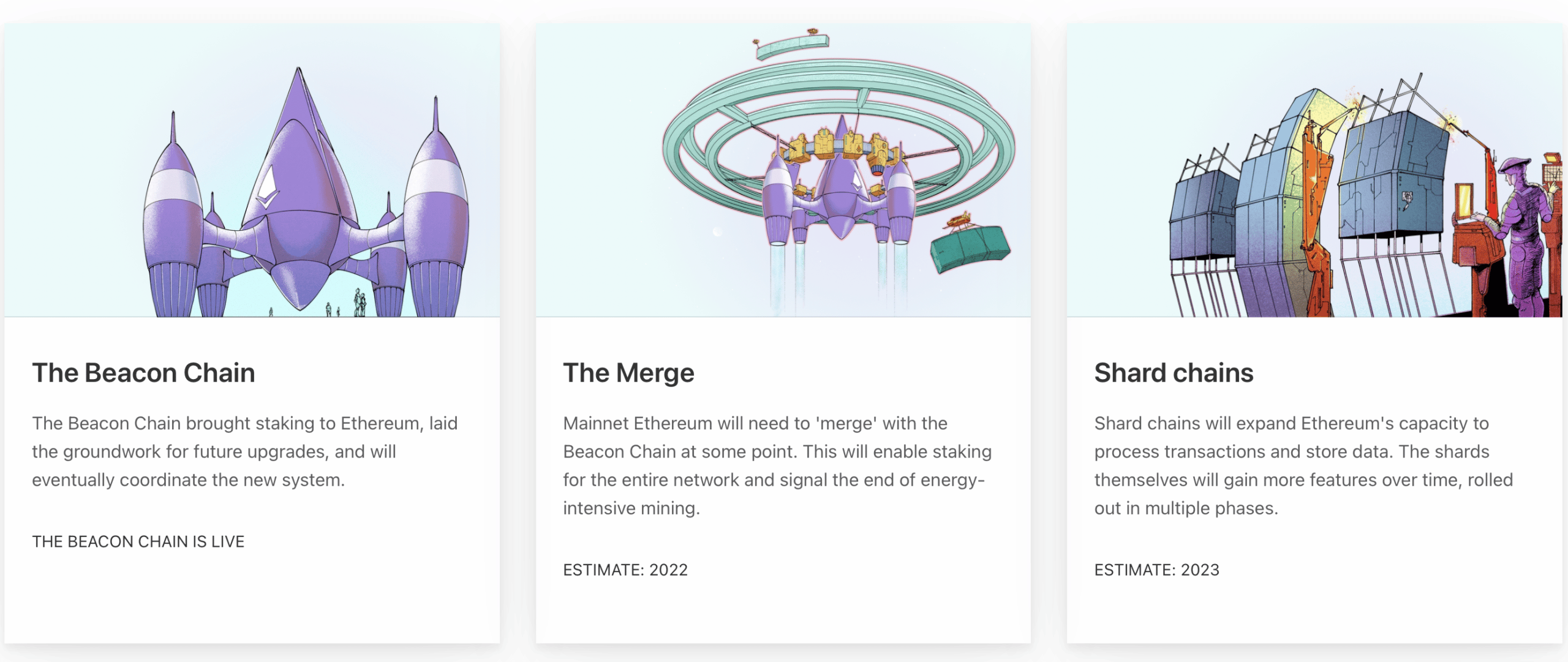
Once the main Ethereum network merges with the beacon chain, ETH mining as we know it will come to an end. However, that does not mean you should immediately abandon all thoughts of mining Ether.
- All the equipment you buy now can still be used later to mine other cryptocurrencies, as Ethereum does not require any specialized hardware.
- There is still time left, and the merge can be delayed, as many Ethereum updates have been in the past.
At the end of the day, you should carefully consider your potential rewards versus the possible risks. Crypto mining in general is not as profitable as it used to be, especially as the cost of electricity rises while rewards become smaller. Do your own research and don’t forget to diversify your sources of income.
The Mining Algorithm
ETH uses a mining algorithm called “Ethash,” which was designed to be ASIC-resistant. This means that it’s much easier — and more profitable — to mine ETH with a regular computer than with a specialized mining rig.
Bitcoin, on the other hand, uses the SHA-256 algorithm, and thus favors ASIC miners over GPUs.
How Does Ethereum Mining Differ From Bitcoin Mining?
Although the biggest and most defining difference between Ethereum and Bitcoin mining lies in their respective algorithms, it’s not the only one. Here are some others:
| Ethereum | Bitcoin | |
| Algorithm | Ethash | SHA-256 |
| Preferred Miner Type | GPU | ASIC |
| Hash Rate | 34 MH/s | 14000 GH/s |
| Power Usage | 405W | 1370W |
As you can see from the table above, Bitcoin has a more impressive hash rate and mining performance due to being ASIC-compatible, but pays for it with much higher electricity consumption.
Another difference is that you won’t need to purchase a specialized mining rig to mine ETH. You can use your existing CPU or GPU (though we advise against this, as crypto mining is very taxing on hardware).
How Much Do Ethereum Miners Earn?
The amount of profit Ether miners receive depends on two things: how many coins they can mine, the current block reward, and the price of Ethereum at that point in time.
You can calculate your estimated ETH mining profit using one of the many calculators available online, like this one.
The Cost of Mining ETH
In order to mine Ethereum, you will need hardware. That will be the first big expense — but at least in most cases, it will be a one-off payment.
The biggest cost by far, however, is electricity. Mining computers use a lot of energy, and energy costs money. The exact amount varies depending on where in the world you are and how much you’re paying per kilowatt-hour (kWh), but it’s not uncommon for miners to spend $0.20-$0.50 per kWh on bills.
Other significant costs include any potential data center rental fees and cooling costs (since mining computers generate a lot of heat). Additionally, your hardware may need repairs.
Fortunately, there are ways to offset these costs… to a degree. One way is to use a mining rig that is energy-efficient. Another way is to mine Ethereum in a location where electricity is cheap. Additionally, you can also opt to go for pool or cloud mining.
How To Mine Ethereum
With all that out of the way, let’s move on to the main topic of this article: the mining process itself.
Ways To Mine Ethereum
First, let’s take a look at the different ways in which you can mine ETH.
Pool Mining
Setting up your own mining operation can be incredibly taxing on both your wallet and your time (and sometimes, your sanity). Thankfully, alternatives exist. You can always join a mining pool to get ETH for a fraction of the cost.

Ethereum mining pools are groups of miners who work together to mine Ether. By joining a mining pool, you can earn a steady income stream from mining without having to invest in expensive hardware.
There are many different types of mining pools, and each one has its own set of rules and regulations. It’s important to do your research before joining a pool. Some pools may require you to run special software or pay a fee. Others may have minimum hashrate requirements or restrict which countries can join.
Choosing a Mining Pool
Here are the things you should consider when choosing a pool to mine Ether in:
- Pool fee
- Pool size
- Entry requirements
You can find a list of the best ETH pool mining platforms here.
Solo Mining
Another option is to mine Ethereum solo. This means that you’ll be the only one doing the work Ether, and you’ll get to keep all of the mining rewards for yourself.
Solo mining is a risky endeavor, and it’s not recommended for beginners. It’s also worth noting that Ethereum’s PoW consensus algorithm is designed to be ASIC-resistant. This means that special mining hardware (called ASICs) can’t be used to mine ETH.
Cloud Mining
If you don’t want to deal with the hassle of setting up your own mining operation, you can use a cloud mining service. With cloud mining, you rent mining hardware from a company that owns and operates it for you.
This is a convenient way to mine ETH, but it’s important to remember that you’re not actually doing the mining yourself. You’re just renting hashing power from someone else. This means that you don’t have any control over the hardware or software used to mine ETH.
Cloud mining also comes with a number of risks. For one, there’s no guarantee that you’ll actually earn any money. The price of ETH could go down, and the difficulty of mining could go up. This would make it impossible to profit from cloud mining.
Additionally, some cloud mining services have been known to be scams. Always do your research before signing up for any service.
And if you decide that mining isn’t for you, you can always get Ethereum on Changelly.
Can’t load widgetCreate an Ethereum Wallet
You will need to get a good and reliable crypto wallet that supports Ethereum before you start mining it. If you want to go for a hardware one, Ledger or Trezor would be a great choice. If you don’t plan on hodling your ETH, hot wallets like MyEtherWallet or Enjin may be a better pick. Read more about Ethereum wallets here.
Prepare Your Hardware and Software
If you’ve decided to take the plunge and mine Ethereum, you’ll need to invest in some equipment. First, you’ll need a computer with a decent amount of processing power. Mining can be resource-intensive, and your profits will directly depend on the performance of your hardware.
You’ll also need to install mining software. There are a number of different options available, and it’s important to choose one that’s compatible with your operating system and mining hardware.
Once you have everything set up, you’ll be ready to start mining ETH.
The Best Software For Your Ethereum Mining Operation
Beware of scams and viruses when downloading any software. Always make sure you’re on the correct website — criminals sometimes set up platforms that are identical to original ones, eager to catch inattentive miners.
NBMiner
This Ethereum mining software was designed by Chinese developers for Chinese miners, but it can also be used by miners from other countries. It supports Windows and Linux, as well as both AMD and NVIDIA GPUs. It can establish an SSL connection to mining pools.
This software can be used for mining quite a few cryptocurrencies: ETH, AE, RVN, BEAM, CFX, and ERGO. The dev fee for Ethereum in particular is only 1%.
NBMiner can be rather complicated to use, but the developers provided a very detailed how-to guide on this program on its GitHub page.
PhoenixMiner
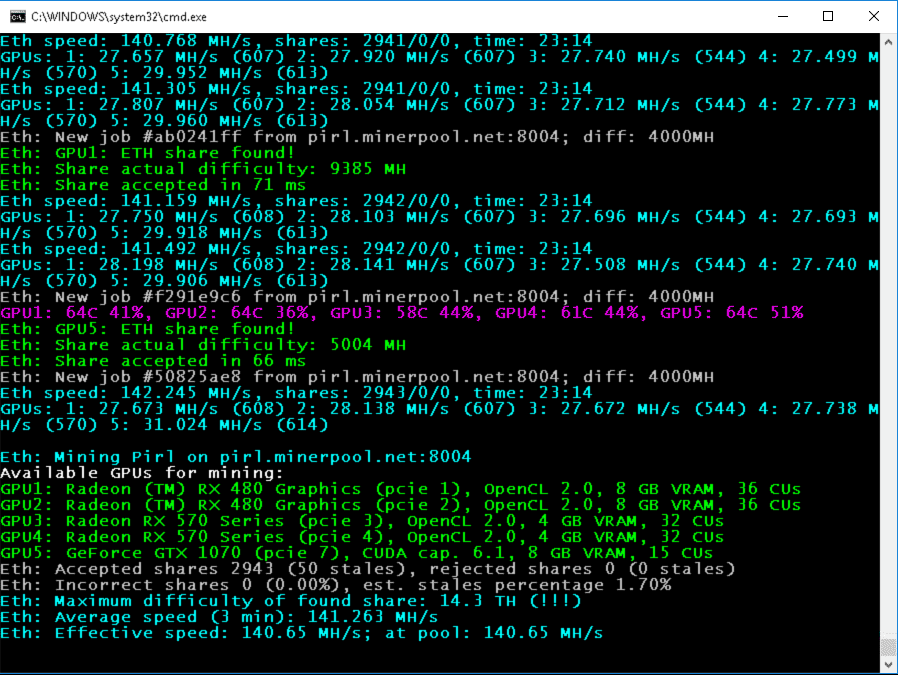
While PhoenixMiner does not have the dual mining option, it can offer its users lower dev fees and a high level of stability. This software supports both AMD and NVIDIA cards and can be run on either Windows or Linux machines. The PhoenixMiner Ethereum GPU miner software perfectly suits Windows 10.
You can use PhoenixMiner to mine other coins based on the ethash algorithm (Ethereum Classic, MOAC, etc.) The dev fee is 0.65%.
TeamRedMiner
TeamRedMiner is an optimized Ethereum mining software for AMD GPUs that supports both Windows and Linux operating systems. The miner works great with Radeon RX Vega series graphics cards. This mining software developers’ fee for mining ethash with a 4GB Polaris is 0.75%. If you use other GPUs when mining the ethash algorithm with TeamRedMiner, the dev fee will rise up to 1%.
CudoMiner
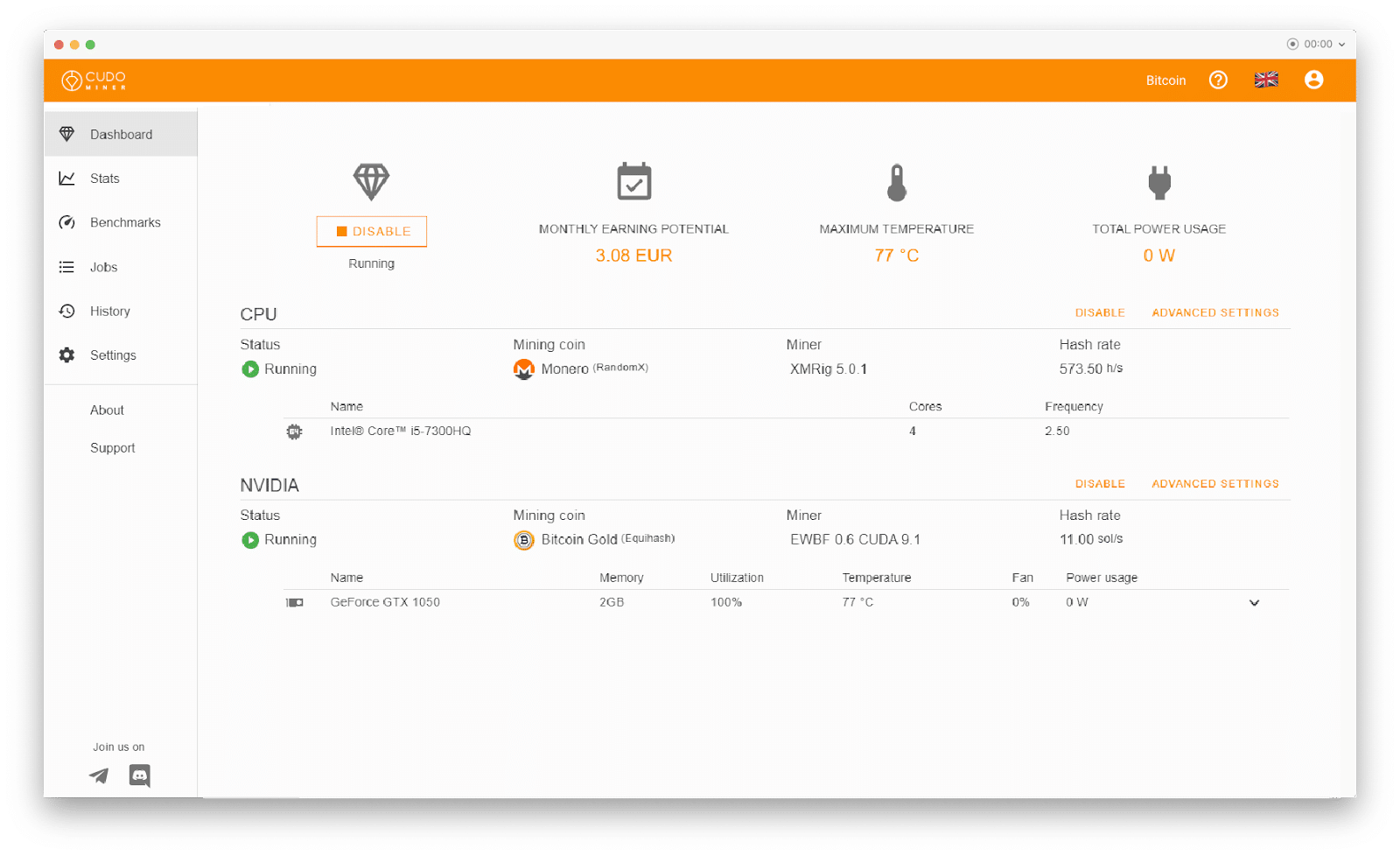
This software has one of the best user interfaces on the market. It is pleasant to the eye, and it is also easy to use. It can auto-switch your settings to help you get maximum profit and can even help you set up things like overclocking. In addition, CudoMiner’s website is also extremely user-friendly and offers a lot of beginner guides to mining.
CudoMiner supports a variety of cryptocurrencies, as well as both NVIDIA and AMD graphics cards. Additionally, it works on both Windows and Linux systems. They don’t have a fixed dev fee but say it should be about 3% for mining rig owners.
GMiner
GMiner is an Ethereum mining software that was created by a group of Russian developers. Its first version was released back in September 2018.
This ETH miner is well-loved by users and supports both NVIDIA and AMD graphics cards. It works with the most popular mining algorithms, such as Ethash, ProgPoW, KAWPOW, Equihash, and more.
One of the defining features of GMiner is that it charges its commission continuously instead of interval charges like most other Ethereum miners do. This increases the potential profit users can receive. Its dev fee is 0.65%.
LolMiner
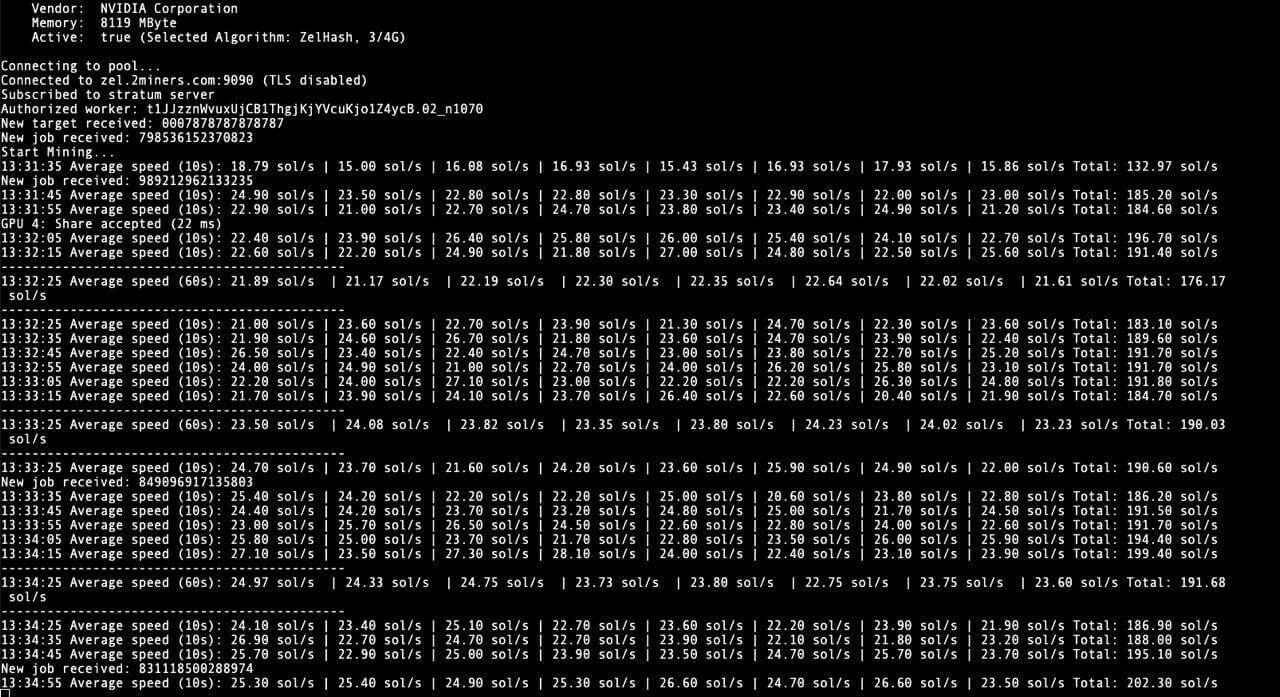
Lolminer was initially made for Equihash and Cuckatoo algorithms. Later, the developers started supporting more coins, allowing users to mine coins on the ethash algorithm. This software is primarily produced for AMD graphics cards. Even though the program supports the majority of the NVIDIA graphics cards, stability and work speed are not guaranteed. The dev fee is 1%.
T-Rex Miner

T-Rex miner works with a variety of algorithms — there are more than 30, including ethash, astralhash, dedal, honeycomb, kawpow, lyra2z, sha256q/t, x11r, etc. It was made to work with NVIDIA graphics cards and supports both Windows and Linux. The developer fee is 1%.
T-Rex miner has implemented various features over the years — for example, the ability to set up the GPU temperature color. Additionally, the T-Rex miner will continue to work even in case of a lost connection.
The Best Ethereum Mining Hardware
| Name | Price | Hashing Power | Power Draw |
| AMD RX 580 | $300 | 32.74 MH/s | 84 W |
| NVIDIA GeForce RTX 3060 Ti | $400 | 60 MH/s | 120 W |
| NVIDIA Titan V | $2000 | 70 MH/s | 250 W |
| NVIDIA GeForce GTX 1070 | $750 | 26 MH/s | 200 W |
| NVIDIA GeForce GTX 1080 Ti | $820 | 43.5 MH/s | 220 W |
| NVIDIA GTX 1060 | $300 | 18 MH/s | 60 W |
| AMD Radeon RX 5700 XT | $1300 | 55 MH/s | 225 W |
| AMD Radeon RX 570 | $230 | 30 MH/s | 70 W |
| AMD Radeon R9 HD 7990 | $150 | 36 MH/s | 375 W |
| AMD Radeon RX Vega 64 | $599 | 50 MH/s | 150 W |
Side note: most of the prices listed in this table are the official ones, but due to supply shortages, some GPUs will only be sold by resellers at a higher price. This is especially true for newer, really popular graphics cards such as NVIDIA GeForce RTX 3060 Ti.
Hardware varies wildly in price, hashing power, and power consumption. Some GPUs have a high level of power efficiency, like AMD RX 580, while others are power-hungry and expensive to boot.
All of these rigs are more than suitable for mining Ethereum and making a profit, so you should choose one that would strike a balance between the resources you can spare and the power you need. Remember to take power consumption into account on par with the device’s initial price — especially if you live in one of the countries where the electricity fees are high.
Additionally, remember that in most cases, you will be able to resell the GPU in the future if you grow tired of Ethereum mining or if it becomes impossible to be carried out due to the switch from the PoW consensus algorithm to the PoS one. Alternatively, these GPUs can still be used to mine other cryptocurrencies, like Litecoin or Dogecoin.
How To Find The Best Mining Hardware?
When looking for the best hardware, the best thing you can do is first make a list of your available resources and future plans. Additionally, you should also keep your expectations in check. If you want to make a lot of money by mining, you should understand that you will also have to spend a lot at the beginning to get all the necessary equipment.
Make sure to only buy hardware from reputable sources if you are serious about this venture. Avoid buying second-hand equipment if you can.
What Settings Are “Safe” for 24/7 GPU Mining?
GPU mining can be very profitable, but at the same time, it can also be really hard on your mining rig. Mining consumes a lot of power and often causes one’s PC to overheat — that is why it is not recommended to mine on CPUs or laptops.
In order to avoid wasting all of your hard-earned profit on hardware upgrades and repairs, you should take good care of your device. Increasing your rig’s longevity is essential if you want to profit from Ethereum mining.
There are even some tricks you can use to make your device more efficient at mining Ether, and most of them are absolutely free.
Temperatures and Fan Speeds
Be careful to prevent your computer’s temperature from rising above 50-60 degrees Celsius — it is not healthy for mining rigs to remain at temperatures above that for a long time. Remember, heat is the main enemy of any PC.
There are several ways to reach the optimum temperature. Firstly, if you run several GPUs, it would be a good idea to get a special mining case. These are usually rather open and allow you to mine crypto without creating a sauna in your PC case.
Secondly, do not neglect your fans. They play a huge role in cooling your mining rig and extending its lifecycle. It is not advised to run your fans at 100% speed, so you should make sure that your rig won’t require that to stay cool. Invest in better fans, get a few of them, and don’t forget to keep them in good shape.
Additionally, you should also consider placing a power limit on your GPU, limiting how much power your rig can use. While this may seem counter-intuitive, it helps to extend hardware’s life and makes the mining process a lot more sustainable and profitable in the long run.
Another thing to consider is the manufacturer that produced your GPU. Two graphics cards that have the same model can differ quite drastically depending on who made them — MSI or Defender, ASUS or Gigabyte, and so on. The more expensive GPUs are naturally more durable and are less likely to be faulty, while the cheaper ones can often have overheating issues.
GPUs and Memory Overclocking
Overclocking refers to the process of increasing clock and memory speeds beyond what was intended by the manufacturer. It can significantly increase your profits when mining cryptocurrency. Overclocking will increase the hash rate of your GPU, and it can also help to lower power consumption and, with it, electricity costs.
By balancing overclocking and power limits, one can increase the hash rate without raising (or even while lowering) power consumption.
FAQ
Is Ethereum mining profitable?
Ethereum mining is no longer possible and thus no longer profitable. If you have any leftover equipment, you can either sell it or use it to mine other cryptocurrencies.
How long does it take to mine 1 Ethereum?
In the past, Ethereum’s block time (the time it takes to mine one block) was only 10 to 20 seconds, but due to high demand and thus increased complexity, the time it actually took to mine 1 Ether could vary wildly. At the time of writing, however, Ethereum is no longer mineable.
Can you mine 1 Ethereum daily?
No, you can’t mine 1 ETH in one day. It has never been possible, and now, post-Merge, Ethereum cannot be mined anymore at all.
How do I start mining Ethereum?
You can no longer mine ETH. However, you can stake it instead. Learn more about Ethereum staking in this article.
Disclaimer: Please note that the contents of this article are not financial or investing advice. The information provided in this article is the author’s opinion only and should not be considered as offering trading or investing recommendations. We do not make any warranties about the completeness, reliability and accuracy of this information. The cryptocurrency market suffers from high volatility and occasional arbitrary movements. Any investor, trader, or regular crypto users should research multiple viewpoints and be familiar with all local regulations before committing to an investment.




